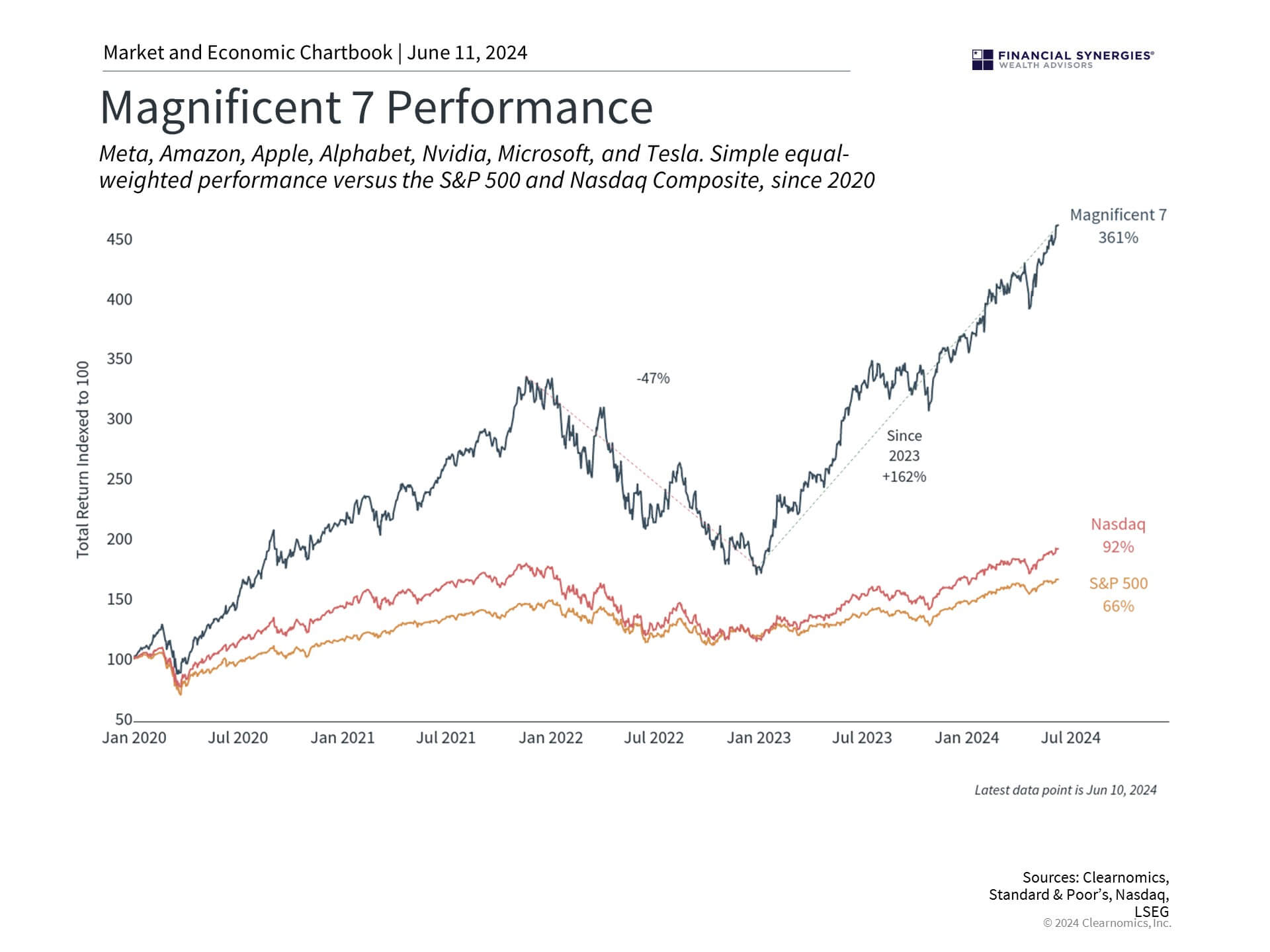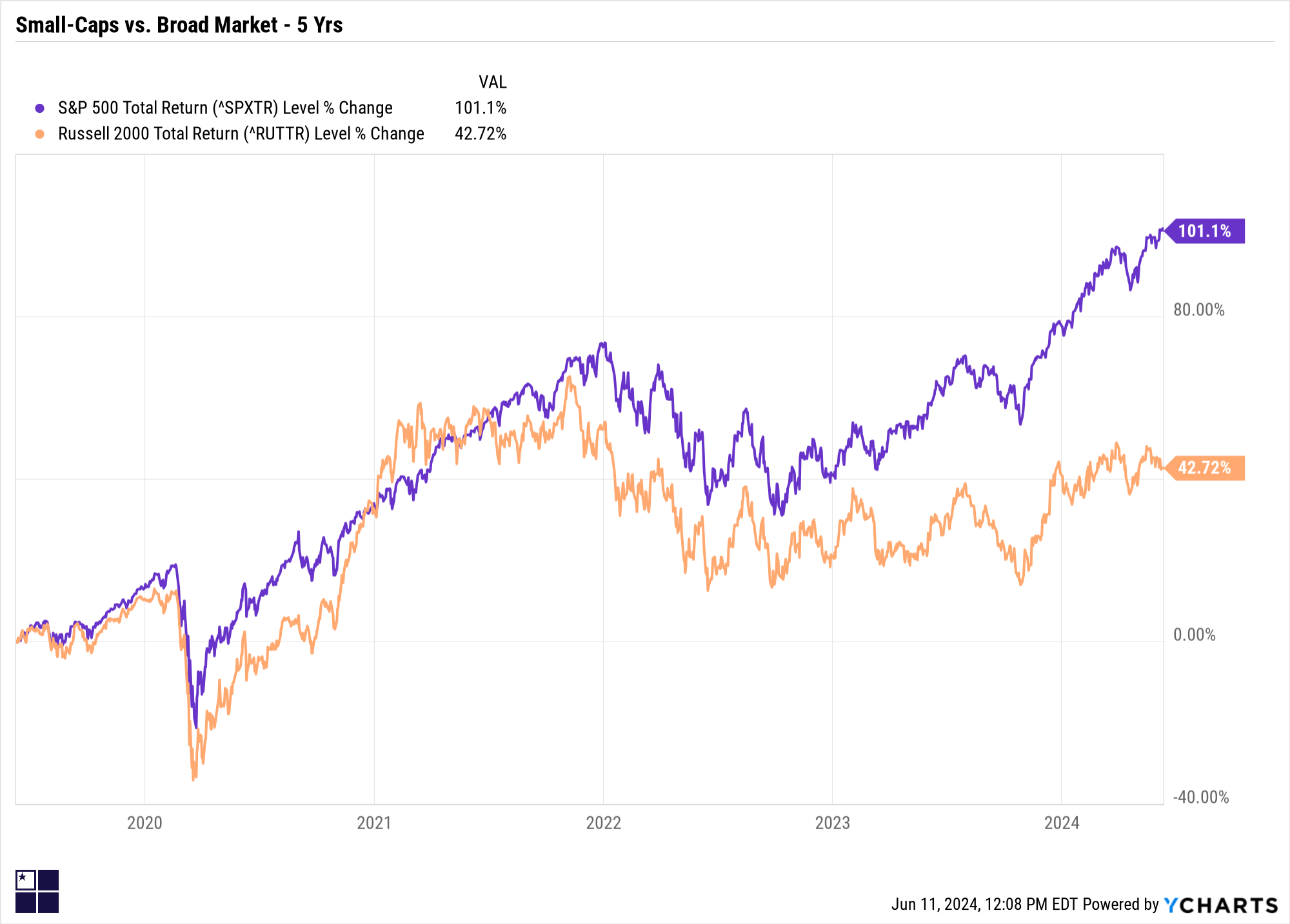With the broad market rallying, small-cap stocks haven’t exactly blown the doors off recently. So, what’s going on?
Small-cap stocks have faced significant challenges in recent years, underperforming compared to their larger counterparts. This trend has continued into 2024, driven by a combination of economic factors and market dynamics. Let’s delve into the reasons behind this underperformance and explore the potential outlook for small-cap stocks.
Economic Headwinds and Market Dynamics
Interest Rates and Economic Sensitivity
One of the primary reasons small-cap stocks have struggled is their sensitivity to interest rates. Small-cap companies often rely more heavily on borrowing to fund their operations compared to larger firms. As a result, persistent high interest rates have had a more pronounced negative impact on small-cap stocks. Higher borrowing costs can squeeze profit margins and limit growth opportunities for these smaller companies.
Investor Preference for Mega-Cap Tech Stocks
The market has seen a significant shift in investor preference towards mega-cap tech stocks, often referred to as the “Magnificent 7” (Apple, Alphabet, Microsoft, Amazon, Meta, Nvidia, and Tesla). These companies have attracted massive inflows, overshadowing smaller companies. This trend has been exacerbated by the structure of market-cap weighted indices, which increase the weight of stocks as their prices rise, leading to a more concentrated and “top-heavy” market.

Economic Uncertainty and Volatility
Small-cap stocks are generally more volatile and economically sensitive. The economic uncertainty and volatility seen in recent years, including concerns about recessions and banking crises, have disproportionately affected small-cap stocks. For instance, the failures of Silicon Valley Bank and Signature Bank in 2023 significantly impacted small-cap banks, leading to a sharp decline in their valuations.
Performance Metrics
Comparative Returns
To illustrate the performance disparity, consider the returns of various indices. In the first quarter of 2024, the Russell 2000 Small-Cap Index returned 5.18%, while the S&P 500 Index returned 10.56%. Over the past five years, small-caps have returned 42.72% compared to 101.1% for the broader market. This significant underperformance highlights the challenges faced by small-cap stocks.

Valuation Gaps
Despite their struggles, small-cap stocks are trading at historically attractive valuations. For example, the forward P/E ratio of the S&P 500 is 21.5x compared to 14.9x for the S&P 600, indicating a significant discount for small-cap stocks. This valuation gap suggests potential for future outperformance if economic conditions stabilize.
Potential for a Turnaround
Historical Outperformance
Historically, small-cap stocks have outperformed larger stocks over the long term. Since 1925, small-caps have generally delivered higher returns coming out of economic downturns. This historical trend provides a basis for optimism about the future performance of small-cap stocks.
Structural Shifts and Reshoring
Small-cap companies may benefit from structural shifts in the economy, such as deglobalization and reshoring of manufacturing operations. Policies like the U.S. CHIPS Act and the Inflation Reduction Act are expected to support these trends, potentially boosting the fundamentals of small-cap companies.
Active Management Opportunities
The lower volume of research and coverage in the small-cap space creates opportunities for active managers to identify “hidden gems” and generate positive excess returns. Historically, active managers have outperformed in the small-cap segment, making a strong case for active management in this asset class.
Conclusion
While small-cap stocks have faced significant challenges in recent years and continue to struggle in 2024, their attractive valuations and historical performance trends suggest potential for a turnaround. Although they’ve had a bad run, as economic conditions evolve, small-cap stocks may once again prove to be a valuable component of a diversified investment portfolio.
Sources:
https://www.americancentury.com/insights/should-investors-take-a-closer-look-at-downtrodden-small-cap-stocks/
https://www.morningstar.com/markets/will-small-company-stocks-ever-catch-up
https://www.glenmedeim.com/the-quarterly-statement-q1-2024-leaning-into-equal-weight-and-small-cap/
https://www.wellington.com/en/insights/small-cap-value-stocks-strong-past-bright-future
Concerns or questions about how your investment portfolio will hold up in the current market environment? Contact Financial Synergies today.
We are a boutique, financial advisory and total wealth management firm with over 35 years helping clients navigate turbulent markets. To learn more about our approach to investment management please reach out to us. One of our seasoned advisors would be happy to help you build a custom financial plan to help ensure you accomplish your financial goals and objectives. Schedule a conversation with us today.
More relevant articles by Financial Synergies:
Why Have Small-Cap Stocks Struggled?
With the broad market rallying, small-cap stocks haven’t exactly blown the doors off recently. So, what’s going on?
Small-cap stocks have faced significant challenges in recent years, underperforming compared to their larger counterparts. This trend has continued into 2024, driven by a combination of economic factors and market dynamics. Let’s delve into the reasons behind this underperformance and explore the potential outlook for small-cap stocks.
Economic Headwinds and Market Dynamics
Interest Rates and Economic Sensitivity
One of the primary reasons small-cap stocks have struggled is their sensitivity to interest rates. Small-cap companies often rely more heavily on borrowing to fund their operations compared to larger firms. As a result, persistent high interest rates have had a more pronounced negative impact on small-cap stocks. Higher borrowing costs can squeeze profit margins and limit growth opportunities for these smaller companies.
Investor Preference for Mega-Cap Tech Stocks
The market has seen a significant shift in investor preference towards mega-cap tech stocks, often referred to as the “Magnificent 7” (Apple, Alphabet, Microsoft, Amazon, Meta, Nvidia, and Tesla). These companies have attracted massive inflows, overshadowing smaller companies. This trend has been exacerbated by the structure of market-cap weighted indices, which increase the weight of stocks as their prices rise, leading to a more concentrated and “top-heavy” market.
Economic Uncertainty and Volatility
Small-cap stocks are generally more volatile and economically sensitive. The economic uncertainty and volatility seen in recent years, including concerns about recessions and banking crises, have disproportionately affected small-cap stocks. For instance, the failures of Silicon Valley Bank and Signature Bank in 2023 significantly impacted small-cap banks, leading to a sharp decline in their valuations.
Performance Metrics
Comparative Returns
To illustrate the performance disparity, consider the returns of various indices. In the first quarter of 2024, the Russell 2000 Small-Cap Index returned 5.18%, while the S&P 500 Index returned 10.56%. Over the past five years, small-caps have returned 42.72% compared to 101.1% for the broader market. This significant underperformance highlights the challenges faced by small-cap stocks.
Valuation Gaps
Despite their struggles, small-cap stocks are trading at historically attractive valuations. For example, the forward P/E ratio of the S&P 500 is 21.5x compared to 14.9x for the S&P 600, indicating a significant discount for small-cap stocks. This valuation gap suggests potential for future outperformance if economic conditions stabilize.
Potential for a Turnaround
Historical Outperformance
Historically, small-cap stocks have outperformed larger stocks over the long term. Since 1925, small-caps have generally delivered higher returns coming out of economic downturns. This historical trend provides a basis for optimism about the future performance of small-cap stocks.
Structural Shifts and Reshoring
Small-cap companies may benefit from structural shifts in the economy, such as deglobalization and reshoring of manufacturing operations. Policies like the U.S. CHIPS Act and the Inflation Reduction Act are expected to support these trends, potentially boosting the fundamentals of small-cap companies.
Active Management Opportunities
The lower volume of research and coverage in the small-cap space creates opportunities for active managers to identify “hidden gems” and generate positive excess returns. Historically, active managers have outperformed in the small-cap segment, making a strong case for active management in this asset class.
Conclusion
While small-cap stocks have faced significant challenges in recent years and continue to struggle in 2024, their attractive valuations and historical performance trends suggest potential for a turnaround. Although they’ve had a bad run, as economic conditions evolve, small-cap stocks may once again prove to be a valuable component of a diversified investment portfolio.
Sources:
https://www.americancentury.com/insights/should-investors-take-a-closer-look-at-downtrodden-small-cap-stocks/
https://www.morningstar.com/markets/will-small-company-stocks-ever-catch-up
https://www.glenmedeim.com/the-quarterly-statement-q1-2024-leaning-into-equal-weight-and-small-cap/
https://www.wellington.com/en/insights/small-cap-value-stocks-strong-past-bright-future
Concerns or questions about how your investment portfolio will hold up in the current market environment? Contact Financial Synergies today.
We are a boutique, financial advisory and total wealth management firm with over 35 years helping clients navigate turbulent markets. To learn more about our approach to investment management please reach out to us. One of our seasoned advisors would be happy to help you build a custom financial plan to help ensure you accomplish your financial goals and objectives. Schedule a conversation with us today.
More relevant articles by Financial Synergies:
Recent Posts
Retirement Planning: Social Security COLA and Portfolio Positioning
Last Week on Wall Street: Happy Q3 Results in Upbeat Market [Oct. 27-2025]
Chart of the Month | Consumers Are Optimistic About the Market, But Cautious on Economy
Subscribe to Our Blog
Shareholder | Chief Investment Officer